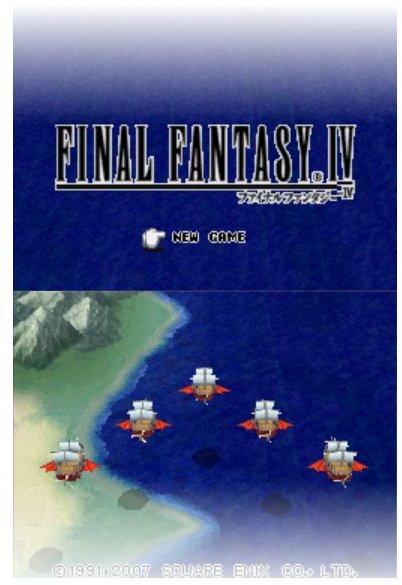A Japanese Game to Learn Japanese
Learning While Having Fun
This article is intended for complete beginners who have no prior experience in Japanese (or very little). It is the first of hopefully a series of article about learning Japanese by playing JRPG (in this case, Final Fantasy IV on the Nintendo DS).
Having been through the process of learning Japanese (and a few other languages), I have designed a methodology which will make learning the language both fun and in just about anyone’s reach.
There are plenty of advantages to learning Japanese, but one of them is certainly being able to play legendary RPGs in their original form (not to mention being able to play them months ahead of everyone else).
As opposed to bombarding the reader with a massive amount of new information right at the very beginning, I intend to integrate the various aspects of the language in a step-by-step fashion in order to avoid indigestible huge chunks of text. Also provided are plenty of opportunities to put the language into use through various exercises in order to optimize both language input and output. I will also aim not to explain grammar in a generic, abstract sort of way but rather rely on the contexts the game has to offer to make things more exciting.
I hope you find learning Japanese as fun and as interesting as I did, especially through such a great vessel as Final Fantasy IV.
Lesson 1
Final Fantasy IV: The Main Characters (in Japanese)
Japanese is written using three different writing systems (four if you include romaji) or “alphabets” if you will. Let us get familiar right away with one of the writing systems called “Katakana”. “Katakana” is composed of 46 basic characters and is used for Japanese words of foreign origins but also for proper names in Final Fantasy IV.
Each of the following characters has a phonetic (sound) equivalent.
Let’s just look at five of those characters for now:
ロ= ”ro”
ザ= “za”
シ=”shi”
セ=”se”
ル=”ru”
Now if I put both characters together to form one name, can you guess which character of the whole cast I’m referring to ((the ー lengthen the vowel of the preceding syllable)? In order to find the answer, simply read the characters out loud.
ローザ:…
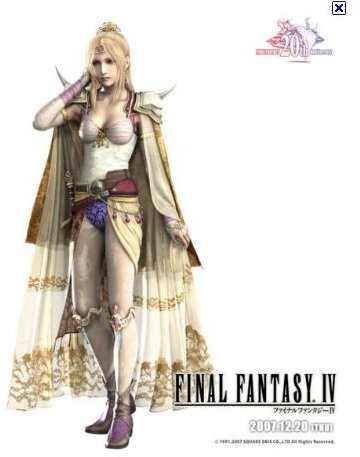
That’s right, it’s Rosa. The great thing with words written in Katakana is that you can guess the meaning of the word simply by reading the word out loud (as will sound very similar to the original word).
Exercise #1: Katakana
The following names are all important characters in FF IV. By using the Katakana chart below, try to match each name (in katakana in the left column) with their name in the English version (names in the right column). You can find the answers at the very end of the article.
I would strongly recommend downloading the worksheet which I have uploaded right here, at Bright Hub (pdf format). It will be a lot more convenient than clicking each image separately.
Katakana Chart (partial):
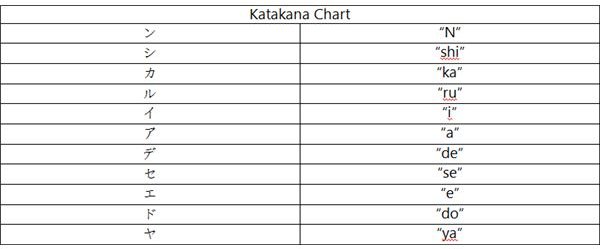
Exercise #1:

Answers to Exercise #1:

In the Next Lesson…
In the next article, we’ll continue to cover the basics of Japanese and start the game!
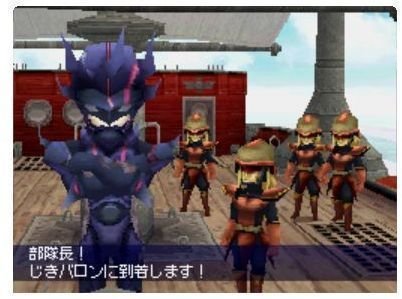
Before we part, however, look at the screen above and try to identify the three different kinds of writing systems as this is what we’ll talk about next time!
じゃまた!
Lesson 2
As usual, all the pictures in this article have been included in this file for your convenience (.pdf format). I suggest downloading the files especially for the review exercise.
Different Kinds of Writing
In this lesson #2, we’ll continue where we left off last time.
Let’s once again take a look at this screenshot from the very beginning of the game.

Now, in the first lesson, you had to try to identify the three different kinds of writing. Let’s look at the answer and explain them briefly.
Answer
Katakana (3): バ、ロ、ン
Hiragana (5): じ、き、し、ま、す
Kanji (5): 部、隊、長**,** 到, 着
Before we move forward, let’s look at the answers in greater detail. If you look at the Katakana (バ、ロ、ン), you’ll notice that the shape of the three characters is angular whereas the Hiragana characters (じ、き、し、ま、す) are made up curves and longer strokes. It won’t take long before you can differentiate the two.
Which takes us to the third writing system, the Kanji (部,隊,長, 到, 着). Those are probably the easiest to differentiate because they look so different than their counterpart. In this lesson, I’d like to talk a bit more about the mysterious Kanji as it causes a lot of trouble for new and advanced learners of Japanese.
Hiragana
We’ve already covered some Katakana in the first lesson (although not all of them). Now let’s talk a bit about the Hiragana.
Just like Katakana, each Hiragana can be read and voiced just like a letter in our English alphabet.
For instance:
じ= “ji”
き= “ki”
し= “shi”
ま= “ma”
す= “su”
So for instance, します (at the very end of the dialogue) would be read “shimasu” and じき would be read “jiki”.
Here’s a table of all of the Hiragana with their sound transcription:

“Dakuten” and “Handakuten”
The “dakuten” and “Handakuten” refer to those little symbols that sometimes appear right next to some Hiragana or Katakana.
It is a clever way to create yet more sounds from already existent characters.
Have a quick look at the following picture to better understand.
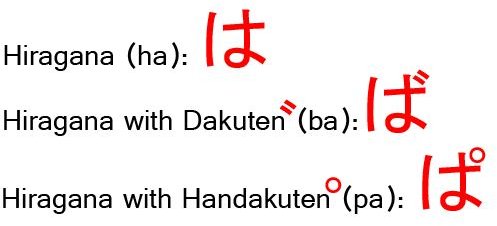
As you can see, the Dakuten and Handakuten slightly modify the original hiragana to create new ones. Here’s another chart with the Dakuten and Handakuten.

Review Exercise #2
Match the Hiragana and Katakana (left column) with the corresponding Romaji (right column).
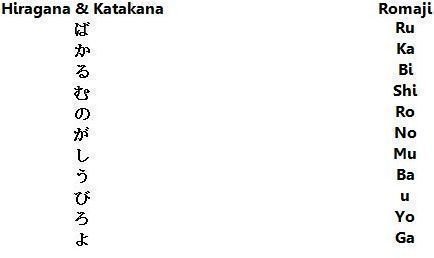
Answer Exercise #2
Here are the answers for the previous exercise:
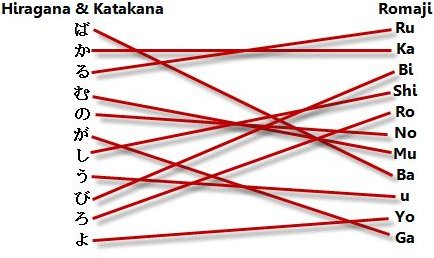
What’s Next?
In the next lesson (lesson 3) we’ll talk a bit more about the mysterious Kanji found in this first dialogue excerpt.
Lesson 3
In the first two lessons, we’ve become more familiar with the Japanese writing system. We’ve practiced reading both Hiragana and Katakana. In this third lesson, we’ll familiarize ourselves with the third writing system: the Japanese Kanji.
The Furigana
For the very last time, let’s once again look at our first screenshot from the game to explain the last element of the writing system: the Kanji.

There are five different Kanji in this short dialogue excerpt: 部, 隊, 長, 到 and 着. Those special characters originate from China (it is actually possible for Chinese speakers to read the Kanji because they have identical or very similar characters in their own language).
The problem with Kanji is that it’s impossible to know how to read them out loud just by looking at them as opposed to Katakana (or Hiragana), which can be easily identified and voiced.
This is why you will often have tiny Hiragana characters on top of Kanji so that the reader knows how to read them, like this:
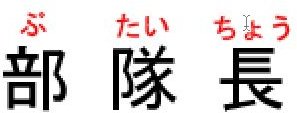
Those little characters (in red) are only there for pronunciation purposes and are called Furigana.
By simply reading the Furigana, you can read the three Kanji: “bu-tai-chou”.
Understanding the Kanji
If you are to be able to read Japanese, you need to have a fundamental understanding of the Kanji.
The first important thing to understand is that, although each character does have one or numerous general meanings, the actual meaning of an individual Kanji depends on the context.
Which brings us to the second important thing to understand: in Japanese, words written in Kanji are often composed of two, three or sometimes more Kanji. In other words, the three Kanji: 部, 隊 and 長 do not mean a word separately, but rather a single word that is composed of three different Kanji.
In other words, although 部 does have a general meaning of “section” (as in a part of something), you really understand its purpose when you see with which other Kanji it is used with, in this case 隊 and長 (this is what I meant by the importance of context).
Indeed, by looking up 部隊長 in a dictionary you will find that it is a Japanese word which can be translated as a sort of commanding officer (translated as Lord Commander in the English version of Final Fantasy IV).
Exercise #3
It is now time to review what we have learned so far. Now that you are familiar with the Hiragana, the Katakana and the Kanji, look at the following screenshots from the beginning dialogue and identify the Kanji in each one. This should be an easy task now and it should take you a few minutes to differentiate the three different writing systems.
Exercise #3
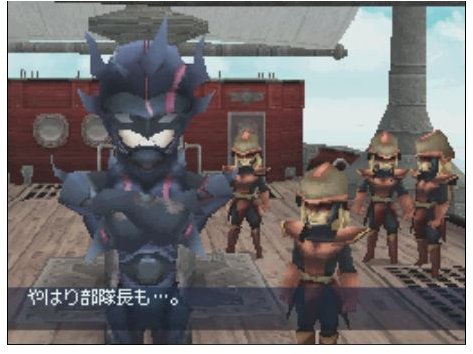

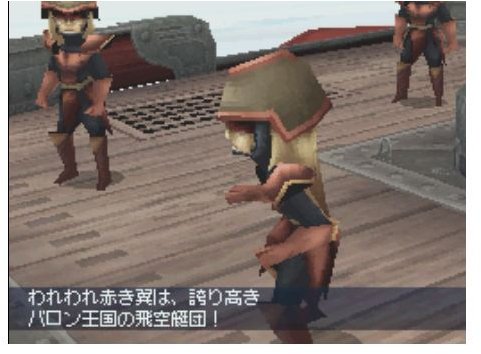
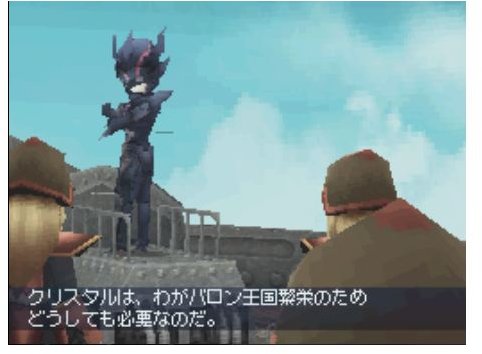
Exercise #3 Answers
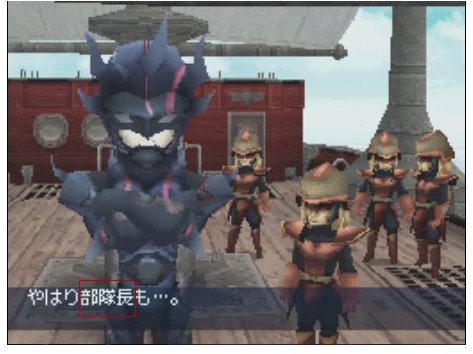
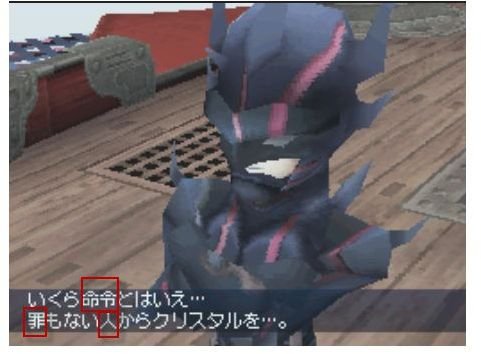
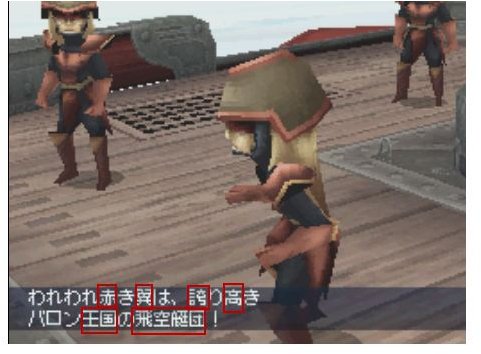
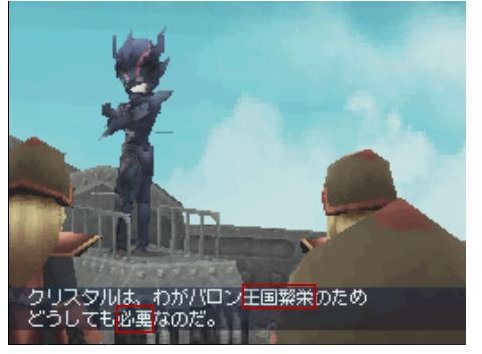
This post is part of the series: Learn Japanese by Playing Final Fantasy IV
Who said that learning a language had to be boring? This guide is meant to introduce the Japanese language step by step to beginners without any prior knowledge of the language, through playing Japanese games on the Nintendo DS.
